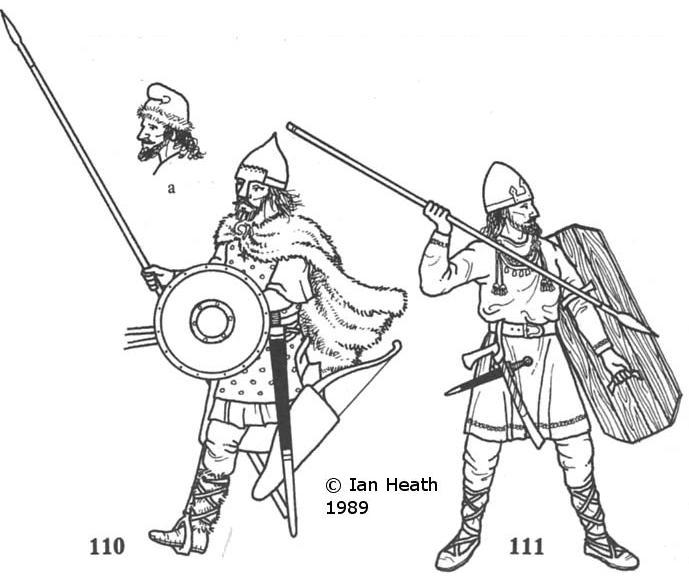 | |
| [Based on a helmet in the Polish Army Museum] | |
LITHUANIAN TRIBESMEN, 12th-13th CENTURIES
An extract from Armies of Feudal Europe 1066-1300by Ian Heath
 | |
| [Based on a helmet in the Polish Army Museum] | |
110 & 111. LITHUANIAN TRIBESMEN, 12th-13th CENTURIES
Starting with Volodar Glebovic of Polotsk in l159 and 1162, from the mid-12th century onwards many Russian and, to a lesser extent, Polish princes began to make considerable use of Lithuanian mercenaries, who quickly earnt a reputation as reliable soldiers of a high standard. Many of them were light cavalry, but others were infantry armed predominantly with spear and axe. After 1279 some Semgallian tribesmen were also equipped with crossbows captured from the Teutonic Knights.*
These figures give a general idea of the appearance of Lithuanians during this period. Basic dress comprised the same woollen or linen tunic and trousers as were worn by the Prussians and Wends, the tunic being short- or long-sleeved depending on the season, and occasionally embroidered. In addition a short fur or woollen cloak was usually worn (this doubling as a blanket on campaign); figure 110 also wears fur wrappings round the lower leg, while others substituted felt boots or cross-gartered leggings (figure 111). Spurs were not worn by Lithuanian horsemen at this date, even though they were in use amongst the neighbouring Kurs. A fur-trimmed cap as depicted in figure 110a might also be worn, while others wore a leather headband. Most Lithuanians had moustache and beard and wore their hair long, this being chiefly dark brown or black.
Over his tunic figure 110 wears a studded leather jerkin for protection, poorer men often substituting a fur jerkin as worn by figures 106 and 107 (indeed, Polish reconstructions of 10th-12th century Lithuanian warriors are indistinguishable from the Prussians depicted above). Helmets were fairly common, and by the 13th century at the latest Lithuanian chieftains and boyars also wore mail or lamellar corselets: certainly the ‘Livonian Rhymed Chronicle’ describes a Lithuanian army in 1260 as equipped with ‘many wonderful mail corselets and helmets of rich gold which glistened like mirrors and whose ornamentation shone like silver’, and this same source refers to armoured Lithuanians and Samogitians in other passages too. These would have closely resembled figure 131. Principal armament comprised a spisa (a slender lance 8-9 feet in length, which according to Henry of Livonia could be thrown), an axe, and a dagger. Richer men might substitute a long iron sword or a sabre for the axe. Most also carried a bow of about 3 feet, the bowcase and quiver being slung from the saddle; this was a self-bow, not a composite weapon, and was used on foot, not on horseback. Shields were bucklers (either of iron-rimmed wood or leather-covered interwoven osiers), small almond-shaped types as depicted in figures 106-108, or rectangular, as carried by figure 111 (a Russian reconstruction of an 11th century Lithuanian foot-soldier). Rectangular shields were in widespread use amongst the Western and Southern Slavs (see also figure 119 below and figures 73 and 142 in Armies of the Middle Ages, volume 2). Curonian shields at least are described as being white, so it seems likely that those of the Lithuanians and Estonians may also have been.
* A Christian captive trained the Semgallians in their use. Crossbows were the Teutonic Knights' ‘secret weapon’, and the Order made every effort to ensure that their enemies did not acquire them. They did not even allow ‘friendly’ natives to handle them. The Prussian Sambians only first captured one in 1262, at Konigsberg, and had absolutely no idea how it worked.